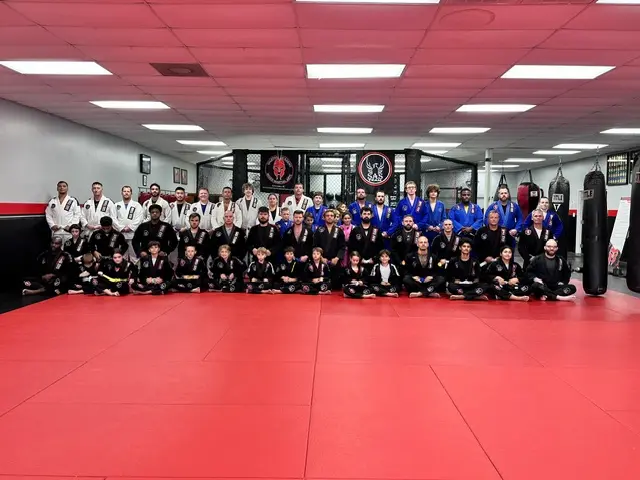Shoulder lock is a grappling technique that uses controlled pressure on the shoulder joint by isolating the arm and maintaining tight body positioning to submit or control an opponent safely and effectively.
Ever wondered how the shoulder lock can become your go-to move when stuck under control? Let’s break down this grappling technique to help you control the fight better and increase your submission success.
Table of Contents
Toggleunderstanding the basics of shoulder locks
Shoulder locks are essential grappling techniques used to control or submit an opponent by applying pressure to the shoulder joint. Understanding the basics involves recognizing how to position your body and secure your opponent’s arm to limit their movement effectively.
The key to a successful shoulder lock is precise control combined with gradual application of pressure to avoid injury and maintain leverage. Common variations include the kimura and Americana, each attacking the shoulder from different angles.
Key Principles of Shoulder Locks
- Control the arm: Secure your opponent’s wrist and elbow to limit their ability to defend.
- Proper positioning: Position your body close to your opponent to maximize leverage and minimize escape routes.
- Apply pressure gradually: Slowly increase force on the shoulder joint to prompt a tap, ensuring safety and effectiveness.
By focusing on these fundamentals, grapplers can develop strong shoulder lock skills that enhance their control and submission options during matches or training sessions.
step-by-step guide to escaping wolf arms control
Escaping the wolf arms control requires precise movements and calm execution. The control involves your opponent trapping your arms, limiting your mobility and setting up for submissions like shoulder locks. Here’s a step-by-step guide to break free effectively.
Step 1: Recognize the Control
Identify when your opponent has secured your arms tightly around their body with a figure-four grip, commonly called the wolf grip. Awareness allows you to plan your escape without panicking.
Step 2: Create Space
Shift your body weight and lower your center of gravity. Use your hips to create space between your chest and the opponent’s, making it harder for them to maintain the grip.
Step 3: Hand Fighting
Focus on breaking your opponent’s grip by gripping their hands or wrists. Applying slow, steady pressure will weaken their hold over time.
Step 4: Hip Escape and Frame
Execute a hip escape by pushing your hips away while framing against your opponent’s hips or chest with your forearms. This movement helps release your trapped arms and regain control.
Following these steps enhances your chance to escape the wolf arms control and improve your defensive skills during grappling sessions.
how to effectively apply and finish a shoulder lock
To effectively apply and finish a shoulder lock, focus on controlling your opponent’s arm and maintaining tight body positioning. Begin by isolating the shoulder joint and securing a firm grip, such as a figure-four or wrist control.
Step 1: Establish Control
Position yourself close to your opponent to limit their movement. Use your arms and legs to immobilize their body and prevent escapes.
Step 2: Secure the Grip
Lock your hands properly, making sure you have a strong hold on their wrist and arm. This grip provides leverage for the submission.
Step 3: Apply Pressure Gradually
Slowly increase pressure by rotating or pushing the arm in the direction that stresses the shoulder joint. Avoid rushing to reduce the risk of injury.
Step 4: React to Defenses
If your opponent attempts to defend by twisting or pulling, adjust your angle or reposition your body to maintain control and continue applying leverage.
Mastering these steps improves your ability to finish shoulder locks with efficiency and safety during grappling exchanges.
adjusting techniques when opponent defends or twists their arm
When your opponent defends or twists their arm to escape a shoulder lock, it’s crucial to adjust your techniques quickly to maintain control. Understanding their movement helps you apply the right counteractions.
Recognize Defensive Movements
Watch how your opponent twists or retracts their arm. These moves aim to relieve pressure or break your grip.
Shift Your Position
Adjust your body angle to follow their movement. Staying close and angling your hips properly can restore leverage and keep the lock tight.
Reinforce Your Grip
Switch grips if needed, such as moving from wrist control to a figure-four grip. Stronger grips increase control and limit their escape options.
Use Controlled Pressure
Apply pressure gradually, reacting to their defense. Sudden force can push them to counterattack or cause injury.
By mastering these adjustments, you can maintain your advantage and increase the likelihood of finishing the submission safely and effectively.
Mastering shoulder locks for better grappling control
Understanding and practicing the basics of shoulder locks improves your control and submission skills in grappling. Learning to escape holds like the wolf arms control strengthens your defense and keeps you safe during matches.
Effectively applying shoulder locks requires proper positioning, grip, and controlled pressure. Adjusting your technique when your opponent defends helps maintain control and increases your chances of success.
Consistent training and attention to detail will help you become more confident and skilled with shoulder locks, giving you an edge in your grappling journey.
FAQ – Shoulder lock techniques and grappling control
What is a shoulder lock in grappling?
A shoulder lock is a submission technique that applies pressure to the shoulder joint to control or submit an opponent.
How can I escape from wolf arms control?
You can escape wolf arms control by creating space with your hips, hand fighting to break grips, and performing a hip escape with proper framing.
What is the key to effectively applying a shoulder lock?
The key is securing a strong grip, maintaining close body positioning, and applying gradual pressure to safely finish the submission.
How do I adjust when my opponent defends against a shoulder lock?
Adjust by shifting your body angle, reinforcing your grip, and applying controlled pressure to counter their twisting or pulling defense.
Why is gradual pressure important in shoulder locks?
Gradual pressure ensures safety by preventing injury and increases the chance of your opponent tapping out without resistance.
Can these shoulder lock techniques be used in all grappling sports?
Yes, shoulder locks are widely used in various grappling sports like Brazilian Jiu-Jitsu, MMA, and submission wrestling for control and submissions.









